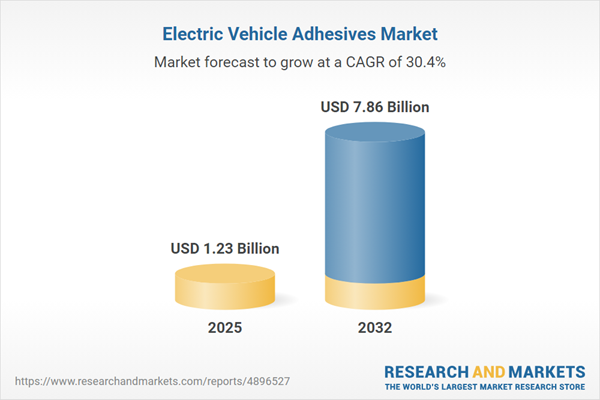Speak directly to the analyst to clarify any post sales queries you may have.
The Electric Vehicle Adhesives Market is evolving rapidly as electric mobility transforms automotive manufacturing, materials innovation, and supplier collaborations across global supply chains. Adhesives, once considered auxiliary, now serve critical roles in ensuring safety, performance, and scalability within electrified vehicle assemblies.
Market Snapshot: Growth Trajectory & Strategic Relevance
The Electric Vehicle Adhesives Market grew from USD 941.93 million in 2024 to USD 1.23 billion in 2025. It is expected to continue growing at a CAGR of 30.37%, reaching USD 7.86 billion by 2032. The market’s swift expansion highlights adhesives as a mission-critical enabler of battery integrity, thermal regulation, EMI control, and production efficiency. This surge underscores their growing importance in electric vehicle architectures and the broader automotive value chain.
Scope & Segmentation
- Adhesive Types: Acrylic Adhesive, Epoxy Adhesive, Polyurethane Adhesive, Silicone Adhesive
- Application Methods: Automated Dispensing, Manual Dispensing
- Functional Applications: Battery Pack Assembly, EMI Shielding (including Conductive Adhesives and Epoxy Based EMI Adhesives), Sealing and Gasketing, Structural Bonding, Thermal Management (featuring Phase Change Materials and Thermal Gap Fillers)
- Vehicle Types: Battery Electric Vehicles, Hybrid Electric Vehicles, Plug In Hybrid Electric Vehicles
- End User Channels: Aftermarket, OEM
- Regional Coverage: Americas (North America: United States, Canada, Mexico; Latin America: Brazil, Argentina, Chile, Colombia, Peru), EMEA (Europe: United Kingdom, Germany, France, Russia, Italy, Spain, Netherlands, Sweden, Poland, Switzerland; Middle East: United Arab Emirates, Saudi Arabia, Qatar, Turkey, Israel; Africa: South Africa, Nigeria, Egypt, Kenya), Asia-Pacific (China, India, Japan, Australia, South Korea, Indonesia, Thailand, Malaysia, Singapore, Taiwan)
- Top Companies: Henkel AG & Co. KGaA, 3M Company, Sika AG, H.B. Fuller Company, Dow Inc., Arkema SA, Huntsman Corporation, Parker-Hannifin Corporation, Illinois Tool Works Inc., Nitto Denko Corporation
Key Takeaways
- Adhesives have shifted to become central, not peripheral, to electrified vehicle design, affecting battery safety and performance as well as manufacturing scalability.
- The choice of adhesive technology now directly influences factors once decided independently—energy density, crashworthiness, and process automation all converge at the adhesive selection stage.
- Automated dispensing and in-line inspection are driving higher production throughput, consistency, and tighter requirements on cure profiles and rheology for suppliers.
- Durability and recyclability priorities are steering the market towards low-emission chemistries and repairable designs, increasing the complexity of qualification and procurement strategies.
- Each segment—by chemistry, functional use, vehicle type, and application method—carries distinct technical and operational priorities, shaping product formulation, joint design, and supplier roles.
- Regional adoption patterns respond to differing regulatory, manufacturing, and ecosystem dynamics, making tailored strategies essential for global market success.
Tariff Impact on Sourcing and Production
Recent US tariffs and trade policy changes are reshaping adhesive sourcing, supplier qualification, and production site decisions. Manufacturers are increasingly exploring nearshoring, dual sourcing, and buffer inventory strategies to mitigate cost volatility and supply chain risks. Suppliers are assessing where to localize specialty adhesive production versus maintain global outputs, while OEMs accelerate validation of regionally produced solutions to ensure resilience amid shifting trade environments.
Methodology & Data Sources
This report draws on primary interviews with materials scientists, engineers, and procurement specialists, as well as secondary research from technical literature and regulatory standards. The mixed-methods approach integrates scenario planning and application-specific validation, ensuring the insights are actionable for manufacturers and sourcing strategists.
Why This Report Matters
- Delivers actionable intelligence to support procurement, engineering, and supply chain decisions for senior stakeholders in EV programs.
- Unpacks the complexities of adhesive technology integration, regulatory changes, and regional manufacturing strategies to inform risk mitigation and long-term supplier selection.
Conclusion
Advanced adhesive technologies are now fundamental to the success of electric vehicles. Cross-functional collaboration and agile sourcing will differentiate leaders as market requirements become more complex. Strategic integration of material innovation, reliable supply, and manufacturing optimization is vital for program continuity and performance.
Additional Product Information:
- Purchase of this report includes 1 year online access with quarterly updates.
- This report can be updated on request. Please contact our Customer Experience team using the Ask a Question widget on our website.
Table of Contents
3. Executive Summary
4. Market Overview
7. Cumulative Impact of Artificial Intelligence 2025
Companies Mentioned
The companies profiled in this Electric Vehicle Adhesives market report include:- Henkel AG & Co. KGaA
- 3M Company
- Sika AG
- H.B. Fuller Company
- Dow Inc.
- Arkema SA
- Huntsman Corporation
- Parker-Hannifin Corporation
- Illinois Tool Works Inc.
- Nitto Denko Corporation
Table Information
| Report Attribute | Details |
|---|---|
| No. of Pages | 188 |
| Published | October 2025 |
| Forecast Period | 2025 - 2032 |
| Estimated Market Value ( USD | $ 1.23 Billion |
| Forecasted Market Value ( USD | $ 7.86 Billion |
| Compound Annual Growth Rate | 30.3% |
| Regions Covered | Global |
| No. of Companies Mentioned | 11 |








